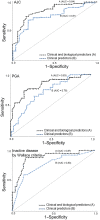Clinical and associated inflammatory biomarker features predictive of short-term outcomes in non-systemic juvenile idiopathic arthritis
- PMID: 31919503
- PMCID: PMC7449798
- DOI: 10.1093/rheumatology/kez615
Clinical and associated inflammatory biomarker features predictive of short-term outcomes in non-systemic juvenile idiopathic arthritis
Abstract
Objective: To identify early predictors of disease activity at 18 months in JIA using clinical and biomarker profiling.
Methods: Clinical and biomarker data were collected at JIA diagnosis in a prospective longitudinal inception cohort of 82 children with non-systemic JIA, and their ability to predict an active joint count of 0, a physician global assessment of disease activity of ≤1 cm, and inactive disease by Wallace 2004 criteria 18 months later was assessed. Correlation-based feature selection and ReliefF were used to shortlist predictors and random forest models were trained to predict outcomes.
Results: From the original 112 features, 13 effectively predicted 18-month outcomes. They included age, number of active/effused joints, wrist, ankle and/or knee involvement, ESR, ANA positivity and plasma levels of five inflammatory biomarkers (IL-10, IL-17, IL-12p70, soluble low-density lipoprotein receptor-related protein 1 and vitamin D), at enrolment. The clinical plus biomarker panel predicted active joint count = 0, physician global assessment ≤ 1, and inactive disease after 18 months with 0.79, 0.80 and 0.83 accuracy and 0.84, 0.83, 0.88 area under the curve, respectively. Using clinical features alone resulted in 0.75, 0.72 and 0.80 accuracy, and area under the curve values of 0.81, 0.78 and 0.83, respectively.
Conclusion: A panel of five plasma biomarkers combined with clinical features at the time of diagnosis more accurately predicted short-term disease activity in JIA than clinical characteristics alone. If validated in external cohorts, such a panel may guide more rationally conceived, biologically based, personalized treatment strategies in early JIA.
Keywords: JIA; arthritis; childhood arthritis; classification; cytokines; machine learning; predictors.
© The Author(s) 2020. Published by Oxford University Press on behalf of the British Society for Rheumatology. All rights reserved. For permissions, please email: journals.permissions@oup.com.
Figures

References
-
- Petty RE, Southwood TR, Baum J. et al. Revision of the proposed classification criteria for juvenile idiopathic arthritis: Durban, 1997. J Rheumatol 1998;10:1991–4. - PubMed
-
- Guzman J, Henrey A, Loughin T. et al. Predicting which children with juvenile idiopathic arthritis will have a severe disease course. Results from the ReACCh-out Cohort. J Rheumatol 2017;44:230–40. - PubMed
-
- Minden K, Kiessling U, Listing J. et al. Prognosis of patients with juvenile chronic arthritis and juvenile spondyloarthropathy. J Rheumatol 2000;27:2256–63. - PubMed
-
- Oen K, Malleson PN, Cabral DA. et al. Disease course and outcome of juvenile rheumatoid arthritis in a multicenter cohort. J Rheumatol 2002;29:1989–99. - PubMed
-
- Berard RA, Laxer RM.. Early aggressive therapy for patients with juvenile idiopathic arthritis: are we there yet? J Rheumatol 2014;41:2343–6. - PubMed
Publication types
MeSH terms
Substances
Grants and funding
LinkOut - more resources
Full Text Sources
Medical
Research Materials
Miscellaneous

